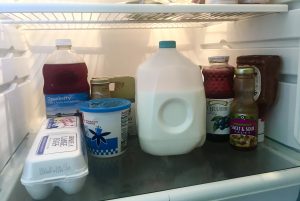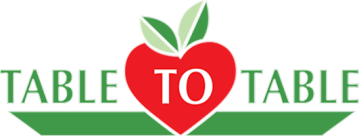Don’t Throw it Out! Food Waste 101
 Food rescue starts at home! Before you start you have to understand sell by/use by/best by food date basics. <<<Did you check that out?
Food rescue starts at home! Before you start you have to understand sell by/use by/best by food date basics. <<<Did you check that out?
Just because the best by date is coming up doesn’t mean you need to toss that milk that’s two days past or bin the chunk of cheese that’s been on the bottom shelf for a couple of weeks. These items and many others can still be used up to a week or more past the sell-by/best-by/use-by date. What many people don’t know is that the best by or use by date isn’t the definitive food safety date for a product (except for baby formula). Most dairy is good up to seven days past the printed date on the carton, eggs can last up to a month in your refrigerator, and most cheeses are good two weeks or more beyond the best by. In addition to refrigerated goods, many canned and dry storage foods can last weeks, if not up to a year beyond their printed date. And if you can’t eat it now, freeze it!
5 Tips for Food Rescue At Home
Forty percent of all food produced in the US doesn’t ever get eaten. Nearly half of that food waste happens at the consumer level.[1] That’s right, almost half of all food waste happens at home, but you can change that statistic! With these five easy tips, you can cut down your food waste by up to 200lbs and save money while saving your food:
- Plan your meals ahead of time: Before leaving for the store, make a rough plan of what you want to cook before your next grocery run and buy only what you need to make those meals.
- Make a grocery list and stick to it: While it is tempting to buy bulk or jump on a sale for obscure produce, make sure it is something that you can incorporate into your usual meal plan.
- Store your food properly: Oftentimes, we find ourselves peering into the depths of a refrigerator at a tupperware long-forgotten on the bottom shelf and wondering, “what was that?” By checking your fridge daily and making sure produce isn’t kept in the coldest spots and leftovers are properly sealed, you can stop playing “what was that,” and fully enjoy the meals you create.

What’s for lunch? Leftovers! - Plan to over-prepare or avoid it altogether: The Cornell Food and Brand lab found that since 2006, serving sizes in the classic cookbook The Joy of Cooking has increased by 36 percent.[2] This increased portion size also contributes to an increase in wasted leftovers. Preparing more food at once certainly has its place. It can be good for the budget AND good for reducing food waste to make more at once. But you have to plan to store it and eat it. Freeze your leftovers to give you a little more time to eat them.
- Don’t neglect leftovers: Just like Mom and Dad told you growing up, clean your plate. Instead of ordering in, make sure your fridge isn’t cluttered with the fajitas you made on Tuesday, or the soup you had last Friday.
Read More About Food Safety and Food Waste
Looking for more detailed information on food safety and date guidelines? See these foodsafety.gov safe cold food storage guidelines.
Want to know more about the problem of food waste and how it happens across the entire food system? Check out this great summary by Foodprint.org.
- https://foodprint.org/issues/the-problem-of-food-waste/
- Lehner, Peter. “Tackling Food Waste at Home.” NRDC, August 21, 2012. Retrieved May 2020, from https://www.nrdc.org/experts/peter-lehner/tackling-food-waste-home

